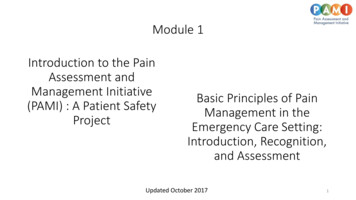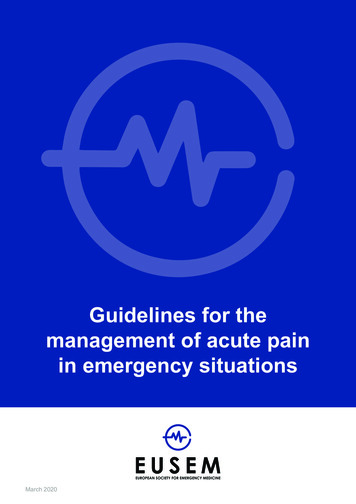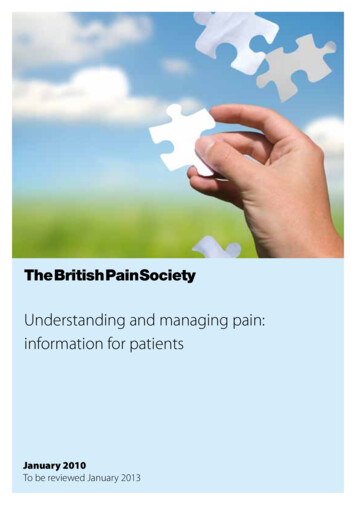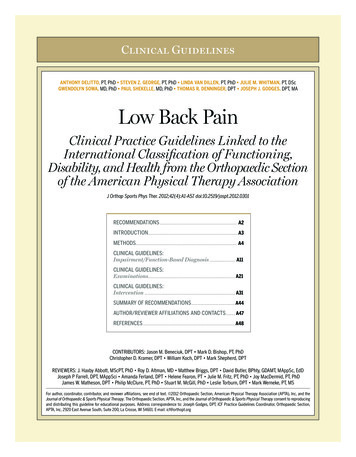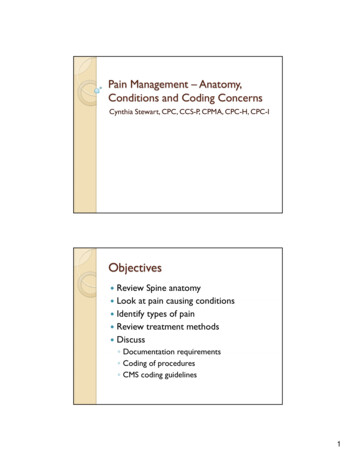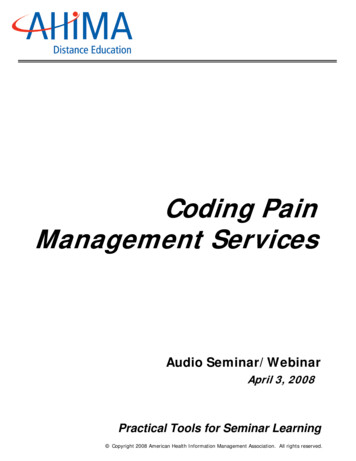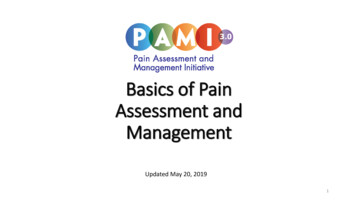
Transcription
Basics of PainAssessment andManagementUpdated May 20, 20191
PAMI learning module content will sometimes overlap due to similar topics. The PAMI websiteoffers access to learning module handouts, PAMI Pain Management and Dosing Guide,resources, toolkits, best practices and recent pain news.We welcome your feedback on all PAMI materials and are interested in how you use them toimprove patient safety, pain education and clinical care.Please email emresearch@jax.ufl.eduFor more information please visit http://pami.emergency.med.jax.ufl.edu/Like Us on Facebook at https://goo.gl/4Yh1cBFollow Us on Twitter @pami painmgmt2
Presentation Information An electronic pdf version of this document is available on the PAMIwebsite mimodule-downloads/ All PAMI created materials are free access and can be utilized foreducational programs or adapted to institutional needs. Suggested Citation: Basic of Pain Assessment and Management.University of Florida College of Medicine - Jacksonville, Department ofEmergency Medicine. Pain Assessment and Management Initiative(PAMI 3.0): Multimodal Approaches to Improve Pain Outcomes andReduce Opioid Risk, [date retrieved]. Retrieved fromhttp://pami.emergency.med.jax.ufl.edu/.3
DisclaimerThe PAMI website, learning modules, and resources are for educational and informationalpurposes only. The PAMI website is not intended as a substitute for professional medicaldiagnosis or management by a qualified health care professional. PAMI is not responsible forany legal action taken by a person or organization as a result of information contained in oraccessed through this website, whether such information is provided by PAMI or by a thirdparty. As new research and clinical experience becomes available, patient safety standardswill change. Therefore, it is strongly recommended that physicians, nurses and otherhealthcare professionals remain current on medical literature and national standards of careand structure their treatment accordingly. As a result of ongoing medical advances anddevelopments, information on this site is provided on an “as is” and “as available” basis.Patient care must be individualized. The use of information obtained or downloaded from orthrough this website or module is at the user’s sole discretion and risk.If you use any links that appear in this website or module to other websites, you will leavethe University of Florida’s website. The University of Florida is not responsible for thecontents of any linked site or any link contained in such a linked site. The University of Floridamay provide such links to you only as a convenience and the inclusion of any link does notimply recommendation, approval or endorsement by the University of any third party site. Allsuch links provided on this website are intended solely for the convenience of users of thissite and do not represent any endorsement, advertisement or sponsorship of linked sites orany products or services offered through sites that are not owned by the University.4
Learning Objectives1. Understand the importance of pain recognition, assessmentand re-assessment.2. Discuss the multi-factorial determinants of pain.3. Identify the different classifications of pain and how thisimpacts treatment selection.4. Discuss the key elements of performing an accurate painhistory and examination.5. Understand the different types of pain scales.6. Describe the consequences of untreated pain.7. Recognize patient safety issues regarding pain management,discharge planning, and transitions of care.5
Consider these case scenarios throughout the moduleA 54 year-old non-English speaking male is brought to the ED by EMS after sustaining a motorcycle collisionapproximately 20 minutes prior to arrival; he is calm and reports mild pain. Simultaneously, a 23 year-oldfemale that was involved in the same accident is brought to the ED. She was the restrained backseat passengerin a pick-up truck; reports “pain all over” and is crying hysterically.A 3 year-old right-handed male presents with his caregiver who reports that the child has complained of painin his right arm since yesterday. When questioned the child denies pain but cries and pulls away when any partof the right upper extremity is touched. He has no obvious deformity or swelling to either arm.A 53 year-old male with chronic back pain underwent knee replacement one week ago. He presents to hisprimary care doctor complaining of persistent post-op pain. The patient reports his prescribed opioid is notcontrolling his pain The pain is limiting his ability to perform his daily activities of living.6
Module Outline1. Introduction to Pain Management2. Defining and Classifying Pain3. How to Perform a Pain Assessmenta.b.Components of the Pain HistoryPain Focused Physical Exam4. Pain Assessment Scalesa.b.Adult Pain Assessment ScalesPediatric Pain Assessment Scales5. Management of Paina.b.c.6.7.8.9.General Principles of Pain Management and Stepwise ApproachRe-assessment of PainConsequences of Unrelieved PainDischarge Planning and Transitions of CarePatient Safety, Regulatory and Legal Aspects of Pain ManagementCase Scenario DiscussionSummary7
1. Introduction to PainManagement8
Why is Pain Management Important? Pain is a complex and common complaint that leads to frequent access of the UShealthcare system. Chronic pain alone affects more Americans than diabetes, cancer, and heart diseasecombined, with an estimated annual cost of 600 billion. Pain is often under recognized leading to inadequate management and numerouspatient safety concerns, particularly in special populations and minority groups. Untreated acute pain may lead to adverse sequelae. With the recent opioid epidemic and advances in pain research, there is a renewedemphasis on early multimodal pain management, nonpharmacologic options andnonopioid alternatives.
General Pain Management Challenges(part 1) Failure to recognize or differentiate pain from anxiety Lack of education for healthcare providers, especially regarding nonpharmcologicmodalities. Safety concerns, fear of patient addiction or prescription legal repercussions Lack of pre-existing physician-patient relationships i.e. knowledge of past medicalhistory Inadequate discharge pain plans resulting in return visits or admissions Pressure to see patients rapidly, especially those perceived to be more critical,which can hinder time for adequate pain assessments and re-assessments10
General Pain Management Challenges(part 2) Physiologically unstable patients are least likely to receive astandardized pain assessment and to receive pain medications Outpatient settings may have limited time to perform full painassessments or to evaluate for psychosocial contributors to pain(e.g. financial stress, impaired sleep, anxiety, etc.) Stereotypes towards patients with chronic pain being drugseekers Analgesic shortages leading to medication errors and changingprotocols And many more!11
Opioid Safety Across the Continuum of Care continues to be a top patient safety concern12
Challenges Summary- Keeping Balance Healthcare providers face the dilemma of balancing safeopioid/analgesic prescribing and high-risk patient recognition withappropriate pain management strategies for those in significant painwhile being mindful of different types of pain, individual pain factorsand comorbidities.
How Does Pain Affect Us? Pain is multidimensional, affecting peoplephysically, psychologically, socially andspiritually. Patients’ responses to pain may be related to: genetics, age, gender, ethnicity,socioeconomic and psychiatric factors,catastrophizing, culture, religion,previous experiences, patientperceptions and expectations, ReligionPsychosocialCulture14
Patient Perceptions A patient’s response to prescribed pain treatment can be influenced byfactors unrelated to actual pharmacological treatments.These factors include:– Perceived effective communication with physicians and nurses by the patient– Perceived responsiveness by the treating team– Perceived empathy by the treating team15
Factors Affecting Patient Response To Painful Stimuli Age, Gender, Ethnicity Socioeconomic and Psychological factors CatastrophizingCulture and ReligionGeneticsPrevious experiencesPatient perceptionsPatient expectations16
Patient Response to Pain and Management:Age and Gender Demographics such as age, gender,race and ethnicity have all beenreported to influence painperception. Studies on the influences of genderand age have had variable results. Overall, patients who identify asfemale display more sensitivity thanmales towards most painfulconditions. Females also arebelieved to express their pain morefrequently and effectively thanmales. Studies have shown differentinterpretations by observers for thesame facial expressions dependingon patient gender. This behavior could explain whypatients are managed differentlyby providers when presenting withthe same injury or painfulcondition.17
Patient Response to Pain and Management:Ethnicity Ethnicity is associated with pain intensity and interference.– One study found African Americans to report higher rates of pain andinterference with daily activities such as sleep.Consider the impact of age, gender and ethnicity on pain assessment andmanagement but beware of labeling or stereotyping- treat the individual patient!18
Patient Response to Pain and Management:Culture and Religion Culture and Religion/Personal Values/CopingMechanisms– How patients cope with pain can be influenced by theirexisting social support system.– Those with strong cultural and religious ties tend to havestronger support mechanisms for dealing with their pain.– Variations in cultural norms can influence how a patientexpresses their pain and how they want their pain to bemanaged.19
Patient Response to Pain and Management:Socioeconomic and Psychological Factors Health disparities research indicates that patients living in rural areasand who are of lower socioeconomic status tend to report higher levelsof chronic pain, pain related disability, and depression. Depression andpain often co-exist (30-60% of pain patients also report depression). Previous pain experiences can alter activity within certain brain regionsresponsible for pain processing resulting in persistent pain. Additionally, mood disorders and other psychiatric disorders have beenlinked to the development of chronic pain. This co-existence hasimportant clinical and financial implications. These patients oftenreport more pain, greater functional disability, worse clinical prognosis,and accrue higher healthcare costs.20
Patient Response to Pain and Management:Pain Catastrophizing Pain catastrophizing is anexaggerative cognitive response toan anticipated or actual painfulstimulus and affects howindividuals experience and expresspain. People who catastrophize tend tomagnify their pain, ruminateabout their pain, and feel helplessin managing their pain. Pain catastrophizing sharessimilarities with depression andanxiety. It has been associated withpain-related outcomes such as painseverity, activity interference anddisability, depression, changes insocial support networks, morefrequent healthcare visits, andopioid usage.21
Examples Of Catastrophizing Magnification: the response thatsymptoms that can be or are greaterthan expected. Ex: “I m afraid thatsomething serious might happen” Rumination: when an individualfocuses repeatedly on attributes ofan event that evoke a negativeemotional response. Ex: "I can t stopthinking about how much it hurts“ Helplessness: the belief that there isnothing that anyone can do toimprove a bad situation. Ex: "There isnothing I can do to reduce theintensity of my pain".22
Patient Response to Pain:Genetics Genetic polymorphisms play an integral role in how patients respond to painfulstimuli and treatment. For example, populations within certain ethnic groups are known to carry geneticmutations of the liver CYP450 enzymes responsible for drug metabolism. Some patients are “ultra-rapid metabolizers” of certain drugs such as codeine. This meansthey convert codeine to morphine more rapidly than other patients, resulting in potentialsupra-therapeutic dosing. Some patients are “slow metabolizers” and do not efficiently metabolize codeine, and thusnever achieve therapeutic levels. Caucasian and African American populations have approximately equalproportions of fast and slow metabolizers, whereas nearly 90% of certain Asiangroups are fast acetylators.23
2. Defining andClassifying Pain24
Classification of Pain Determining the context, history of present illness and type of pain iscomplex and time consuming but is essential to developing asuccessful management plan. Pain may be classified by underlying etiology, anatomic location,temporal nature, and intensity. Underlying etiology refers to the source of the experienced pain.Anatomic location refers to the site of pain within the bodyTemporal nature refers to the duration of the pain.Intensity refers to the degree or level of the pain experience .25
eralAcuteChronicAcute on chronicMildModerateSevere26
Nociceptive Pain is the result of direct tissue injury from anoxious stimulus. Nociceptive pain can be further classified assomatic or visceral pain.UnderlyingEtiology Examples include bone fracture, new surgical incision, and acuteburn injury. Inflammatory Pain is the result of released inflammatorymediators that control nociceptive input and are released atsites of tissue inflammation.NociceptiveInflammatoryNeuropathic Examples include appendicitis, rheumatoid arthritis, inflammatorybowel disease, and late stage burn healing. Neuropathic Pain is the result of injury to nerves leading to analteration in sensory transmission. It can be central orperipheral in nature. Examples include diabetic peripheral neuropathic pain, postherpeticneuralgia, chemotherapy induced pain, and radiculopathy.27
Somatic Pain, also known as musculoskeletal pain,is pain that occurs from injury to skin, muscle,bone, joint, connective tissue and deep tissues.Typically pain is well-localized, sharp and worsewith movement. Examples include lacerations, fractures, and pelvic pain. Visceral Pain is internal pain and typically occursfrom internal organs or tissues that support them.Pain is usually poorly localized and described asvague deep aches, colicky, and/or cramping. Examples include appendicitis, peptic ulcer disease,diverticulitis, endometriosis, and ureteral stones.28
Acute pain is defined as lasting less than 3 months and is aneurophysiological response to noxious injury that shouldresolve with normal healing. Examples include post-operative pain, fractured bones, appendicitis,crush injury to finger, labor and delivery pain. Chronic pain is defined as lasting more than 3 months orbeyond the expected course of an acute disease or aftercomplete tissue healing. Chronic pain extends beyond thetime of normal wound healing with the development ofmultiple neurophysiological changes in the central nervoussystem. Examples include low back pain, neck pain, and chronic pancreatitis. Acute on Chronic pain refers to times of acute exacerbationsof a chronic painful syndrome or new acute pain in a personsuffering from a chronic condition. Examples include a sickle cell exacerbation in a patient with sicklecell disease or an abscess in a patient with sickle cell disease.29
Pain Intensity is determined by pain assessment scores in combinationwith history and physical exam. Pain intensity is subjective and may varyfrom one patient to another. Pain Scales are used to assess and quantifythe intensity of a patients pain. Remember that each scale has its’ ownscoring range and levels for mild, moderate or severe pain intensity. Case scenario 1 is an example of the challenges involved in determining intensitywhere one patient has severe injuries but rates their pain as moderate compared tothe patient with minor injuries who complains of severe “pain all over.”Pain intensity can range from:Scores typically range from:Mild1-4Moderate5-7Severe8-1030
Table 1. Types of pain, mechanism, and clinical examplesTYPES OF PAINMECHANISMCINICAL EXAMPLESPHARMACOLOGICALTREATMENT OPTIONS*UNDERLYING ETIOLOGYNociceptiveThe result of direct tissue injury from a noxious stimuli.InflammatoryThe result of released inflammatory mediators that controlnociceptive input.Bone fracture, fresh surgical incision, andfresh burn injury.Late stages of burn healing, neuritis, andarthritisNeuropathicThe result of direct injury to nerves leading to an alteration insensory transmission.Diabetic neuropathy, peripheral neuropathicpain, and post-herpetic neuralgia.IdiopathicUnknownChronic back pain without preceding traumaor obvious inciting event.May include both opiate and non-opiatemedications depending on injury.Anti-inflammatory agentsTricyclic, selective norepinephrinereuptake inhibitors, gabapentinoids, orantidepressantsMay be difficult to adequately addresspain since underlying etiology is unknown,especially in emergency settings.ANATOMIC LOCATIONSomaticA-delta-fiber activity located in peripheral tissuesVisceralC fiber activity located in deeper tissues such as organsSuperficial lacerations, superficial burns,superficial abscessUterine fibroid pain, pyelonephritis, biliarycolicTopical and/or local anesthetics, opiates,non-opiatesAcute fracture, acute knee sprainOpiate, non-opiatesOpiatesTEMPORAL NATUREA neurophysiological response to noxious injury that shouldresolve with normal wound healing.Pain that extends beyond the time for normal wound healingwith resultant development of multiple nicAn acute exacerbation of a chronic pain syndromeChronic low back pain, fibromyalgia, arthritis Depends on the nature of the pain. Pleaserefer to the module on chronic pain formore detailed information.Sickle cell disease, cancer, rheumatoidarthritis, acute injury in chronic pain patient*Nonpharmacologic management options should be considered at any time for any type of painFor more information on Nonpharmacologic Pain Management, please refer to the pdf or learning module31
3. How to Perform a PainAssessmenta. Components of the Pain Historyb. Pain Focused Physical Exam32
a. Components of the Pain History33
Pain History Elements and QuestionsThe patient’s history and physical exam can be an invaluable source when itcomes to determining the proper diagnosis and course of treatment.Essential elements should include a detailed history of the current pain and, forthose that suffer from chronic pain, their previous pain history.Basics1.2.3.4.5.6.Onset of recent painAggravating and alleviating factorsQuality of pain experienceLocation of painSeverity of painCircumstances of original painFunctionality1. How is pain affecting current levelof function?2. Is patient working?3. How is patient coping with pain?34
Pain History Elements and QuestionsCo-morbidities1. Significant past medical and/orsurgical history2. Chronic diseases (obesity,hypertension, diabetes, etc. )3. Psychosocial and/or psychiatric comorbidities4. Family history of substance abusePsychosocial and psychiatric1.2.3.4.DepressionSuicidal ideation or past suicide attemptsPast psychiatric admissionsPhysical, sexual and/or emotional abuse.Consider using the mnemonics OPQRST, SOCRATES and QISS TAPED to assess pain.35
Pain History Elements and QuestionsEssential elements of Pain History – BasicsBasic ElementsDescription1. Onset of recent pain When did the pain start and what was the patient doing when it started Was the onset sudden, gradual, or an exacerbation of a chronic problem2. Aggravating and alleviating factors 3. Quality of pain experience Ask the patient “Can you describe the pain?” Ideally, this will elicitdescriptions of the patient's pain: whether it is sharp, dull, crushing, burning,tearing, or some other feeling, along with the pattern, such as intermittent,constant, or throbbing.4. Location of pain Where pain is on the body and whether it radiates (extends) or moves to anyother area?5. Severity of pain Ask the patient to describe the intensity of pain at baseline and during acuteexacerbations, typically done using a pain scale6. Circumstances of original pain Identify when the pain started, under what circumstances, duration, onset(sudden/gradual), frequency, whether acute/chronic.What makes the pain better and what makes it worse?How does physical activity or position affect pain?Do any nonpharmacological therapies or medications relieve the pain?36
Consider using a patient pain diagram atcheck-in or triage (if stable)37
Pain History Elements and QuestionsMnemonics for obtaining pain historyOPQRSTSOCRATES Onset of event Provocation andpalliation ofsymptoms Quality Region andradiation Severity TimingSiteOnsetCharacterRadiationAssociationsTime courseExacerbating/Relieving factors SeverityQISS TAPED QualityImpactSiteSeverityTemporalAggravating andalleviating Past response andpreferences Expectations andgoals Diagnostics andphysical exam38
OPQRST What was the patient doing when it started? Were they active, inactive, and or stressed? Did that specific activity prompt or start the onset of pain? Was onset of pain sudden, gradual or part of an ongoing chronic problemOOnset ofeventPProvocation andpalliation ofsymptomsQQualityIs the pain better or worse with: Activity. Does walking, standing, lifting, twisting, reading, etc have any effect of the pain? Position. Which position causes or relieves pain? Provide examples to the patient-- sitting,standing, supine, lateral, etc Adjuvant. Which type of medication relieves the pain (Tylenol, Ibuprofen, etc. )? Does the use ofheat or ice packs alleviate pain? What type of alternative therapy (massage, acupuncture) haveyou used before? Does any movement, pressure (such as palpation) or other external factor make the problembetter or worse? This can also include whether the symptoms relieve with rest. Ask the patient to describe the quality of pain – is it throbbing, dull, aching, burning, sharp,crushing, shooting, etc ? Questions can be open ended "Can you describe it for me?" or leading Ideally, this will elicit descriptions of the patient's pain: whether it is sharp, dull, crushing,burning, tearing, or some other feeling, along with the pattern, such as intermittent,constant, or throbbing.39
OPQRSTRRegion andradiation Where pain is on the body and whether it radiates (extends) or moves to any other area? Referredpain can provide clues to underlying medical causes. Location: body diagrams may help patients illustrate the distribution of their pain. Dermatome map – may help determine the relationship between sensory location of pain and spinalnerve segment (see figure next slide). Referred vs Localized: referred pain (also known as reflective pain) is feeling pain in a location otherthan the original site of the painful stimulus. Localized pain is when pain typically stays in one locationand does not spread.SSeverity Ask the patient to describe the intensity of pain at baseline and during acute exacerbations. The pain score (usually on a scale of 0 to 10) where 0 is no pain and 10 is the worst possible pain. Thiscan be comparative (such as ". compared to the worst pain you have ever experienced") orimaginative (". compared to having your arm ripped off by a bear"). If the pain is compared to a priorevent, the nature of that event may be a follow-up question.TTiming Identify when the pain started, under what circumstances, duration, onset (sudden/gradual),frequency, whether acute/chronic. How long the condition has been going on and how it has changed since onset (better, worse,different symptoms)? Whether it has ever happened before, and how it may have changed since onset, and when the painstopped if it is no longer currently being felt?40
SOCRATESSOSiteWhere is the pain? Or the maximal site of the pain.OnsetWhen did the pain start, and was it sudden or gradual? Include also whether ifit is progressive or regressive.CRACharacterWhat is the pain like? An ache? Stabbing?RadiationDoes the pain radiate anywhere? (See also Radiation.)AssociationsAny other signs or symptoms associated with the pain?TETime courseDoes the pain follow any pattern?Exacerbating/RelievingfactorsDoes anything change the pain?SSeverityHow bad is the pain?41
QISS TAPEDQQualityWhat were your first symptoms? What words would you use to describe the pain? (achy, sharp, burning, squeezing, dull, icy, etc.)Besides sensations you consider to be "pain," are there other unusual sensations, such as numbness?IImpactHow does the pain affect you?How does the pain impact your sleep, activity, mood, appetite (other - work, relationships, exercise, etc.)What does the pain prevent you from doing? (Depression screen) Do you feel sad or blue? Do you cry often? Is there loss of interest inlife? Decreased or increased appetite?(Anxiety screen) Do you feel stressed or nervous? Have you been particularly anxious about anything? Do you startle easily?SSiteShow me where you feel the pain. Can you put your finger/hand on it?Or show me on a body map?Does the pain move/radiate anywhere? Has the location changed over time?SSeverityOn a 0-10 scale with 0 no pain and 10 the worst pain imaginable, how much pain are you in right now?What is the least pain you have had in the past (24 hours, one week, month)?What is the worst pain you have had in the past (24 hours, one week, month)?How often are you in severe pain? (hours in a day, days a week you have pain)?42
QISS TAPEDTTemporal CharacteristicsWhen did the pain start? Was it sudden? Gradual? Was there a clear triggering event?Is the pain constant or intermittent? Does it come spontaneously or is it provoked?Is there a predictable pattern? (e.g., always worst in the morning or in the evening? Does it suddenly flare up?)AAggravating andAlleviating FactorsWhat makes the pain better? What makes the pain worse? When do you get the best relief? How much reliefdo you get? How long does it last?PPast Response,PreferencesHow have you managed your pain in the past? (Ask about both drug and non-drug methods)What helped? What did not help? (Be specific about drug trials - how much and how long?)What medications have you tried? Was the dose increased until you had pain relief or side effects? How longdid you take the drug?Are there any pain medicines that have caused you an allergic or other bad reaction?How do you feel about taking medications?Have you tried physical or occupational therapy? What was done? Was it helpful?Have you tried spinal or other injections for pain treatment? What was done? Was it helpful?EExpectations, Goals,MeaningWhat do you think is causing the pain?How may we help you? What do you think we should do to treat your pain?What do you hope the treatment will accomplish?What do you want to do that the pain keeps you from doing?What are you most afraid of? (Uncovers specific fears, such as fear of cancer, which should be acknowledgedand addressed.)DDiagnostics & PhysicalExamExamine and inspect site, Perform a systems assessment and examination as indicatedReview imaging, laboratory and/or other test results as indicated43
Pain History Elements and QuestionsMedical and Surgical HistoryMedical or surgical issues related to patient’s pain or treatment may include:Cancer Different types of pain may be caused by multiple etiologies: Tumors: involvement of bone, vessels, nerves, body organs Diagnostic procedures: may be painful such as biopsies, lumbar punctures, orvenipuncture Treatment: radiation, chemotherapy, or surgical excisionRecent Surgery Incisional pain Complications such as anastomotic leak, bleeding, compartment syndrome, etc.Other Conditions Diabetes which can lead to neuropathic pain Herpes zoster which can lead to radicular pain Migraines which can lead to mixed etiology44
Patient Factors to Consider When Assessing PainAssessing pain in certain special populations can be challenging andrequires multiple considerations such as: AgeLevel of developmentCommunication skills/languageCognitive skillsPrior pain experiencesAssociated beliefs45
Medical and Pain Communication CardsCommunication cards are usedto assist healthcare providersin communicating with scared,nonverbal or non-Englishspeaking patients and families! History taking andassessment Pain, mechanism of injury Explanation of treatments Procedures and testing Discharge instructionsDownload and print your own set hereMedical Communication Cards or scan the QR code46
b. Pain Focused Physical Exam47
Pain Assessment: Physical ExaminationDuring initial pain assessment, physical examination of the patient should be conducted.You should be examining thepatient’s:ExamplesAppearanceobese, emaciated, histrionic, flat affectPosturesplinting, scoliosis, kyphosisGaitantalgic, hemiparetic, using assisting devicesFacial Expressiongrimacing, tense, diaphoretic, anxiousVital Signssympathetic overactivity, temperature asymmetries48
Pain Assessment: Physical ExaminationYou should be examiningthe Painful Area(s):ExampleInspection Skin: color changes, hair loss, flushing, goose bumps, sweating Muscle: atrophy or spasm EdemaPalpation Musculoskeletal system Flaccidity: extreme weakness (may be from paralysis) Abnormal movements: neurologic damage or impaired sense of proprioception,reduced sense of light touch Limit range of motion: disc disease, arthritis, painNeurological
b. Pediatric Pain Assessment Scales 5. Management of Pain a. General Principles of Pain Management and Stepwise Approach b. Re-assessment of Pain c. Consequences of Unrelieved Pain 6. Discharge Planning and Transitions of Care 7. Patient Safety, Regulatory and Legal Aspects of Pain Management 8. Case Scenario Discussion 9. Summary 7
